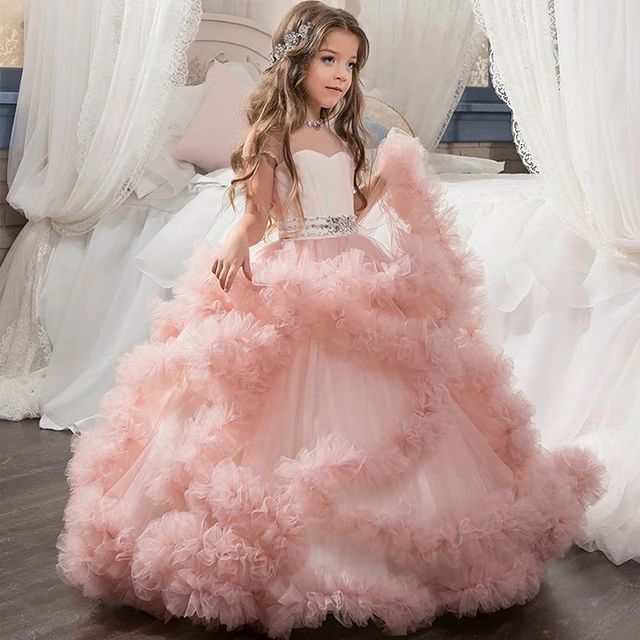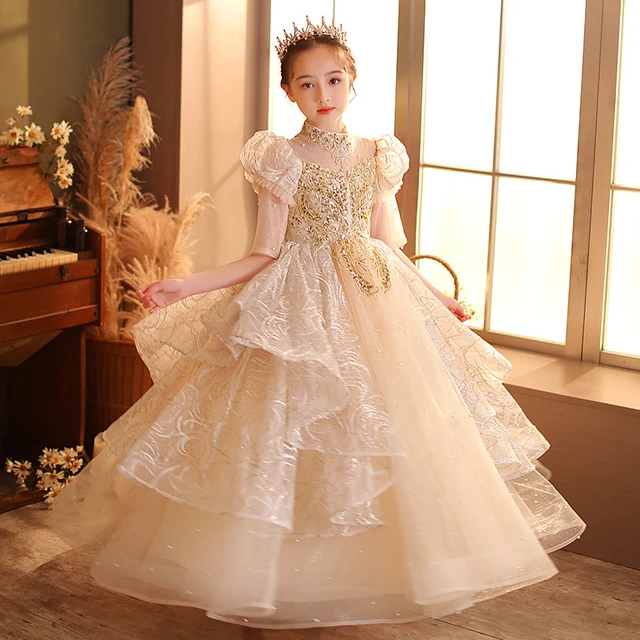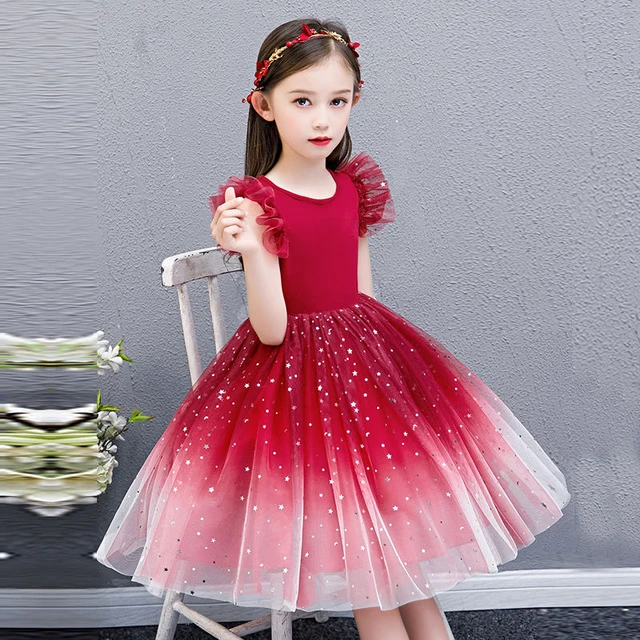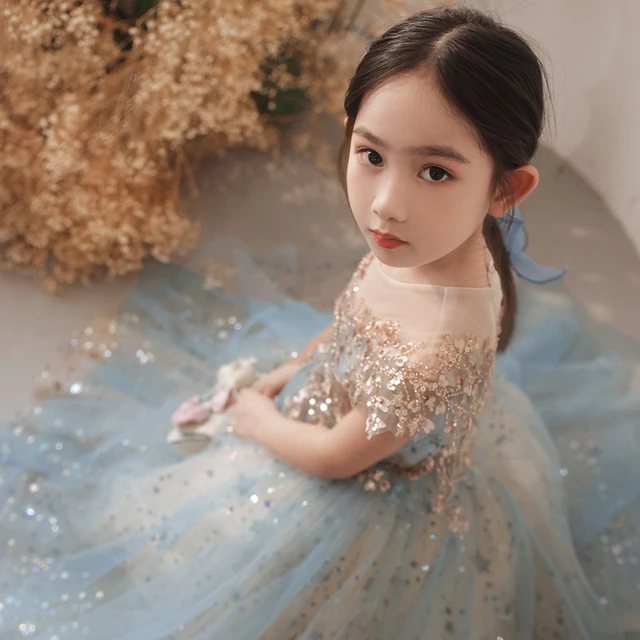Contents
 Introduction:
Introduction:
Girls dresses are a versatile and fashionable choice for various occasions. From playful casual styles to elegant formal dresses, they offer endless possibilities for young girls to express their personal style. In this comprehensive guide, we will explore the sizes and types of girls dresses, the care and maintenance required to keep them in good condition, and tips on how to style them for different looks. By understanding these aspects, you can ensure that girls dresses remain fresh, stylish, and well-suited for any occasion.
 Here are some common materials:
Here are some common materials:
Lace:
Lace is a delicate and intricate fabric that adds a touch of elegance and femininity to girls’ dresses. It is often used as an overlay or detailing on bodices, sleeves, or skirts. Lace dresses are popular for formal occasions and provide a timeless and romantic look.
Satin:
Satin is a smooth and glossy fabric that is commonly used in formal dresses. It has a luxurious appearance and often used for special occasions like weddings or parties. Satin dresses have a beautiful sheen and a soft and silky texture.
Denim:
Denim is a durable and versatile fabric that is often used in casual and everyday dresses. It is a sturdy fabric and provides a more relaxed and laid-back style. Denim dresses are popular for a casual and trendy look.
Sizes and Types of Girls Dresses
Sizes:
Girls dresses are available in a range of sizes, typically indicated by age or body measurements.
Common sizes include toddler, little girl, and tween sizes, which cater to different age groups.
Types of Dresses:
Play Dresses: Play dresses are comfortable and loose-fitting, allowing for freedom of movement during daily activities and playtime.
Party Dresses: Party dresses feature playful designs, vibrant colors, and decorative elements suitable for birthdays or special occasions.
Formal Dresses: Formal dresses, such as ball gowns or cocktail dresses, are crafted with luxurious fabrics and elegant details for formal events or ceremonies.
Lengths:
Knee-Length Dresses: Knee-length dresses fall at or just above the knee, offering a versatile and modest length suitable for various occasions.
Floor-Length Dresses: Floor-length dresses are long and graceful, reaching the floor when worn. They are popular for formal events and special occasions.
Necklines and Sleeve Styles:
Necklines can vary, including round neck, V-neck, scoop neck, or off-the-shoulder styles.
Sleeve options range from short sleeves, long sleeves, cap sleeves, sleeveless, or spaghetti straps.
 Care and Maintenance of Girls Dresses
Care and Maintenance of Girls Dresses
Label Instructions:
Follow the label instructions on each dress for specific care requirements.
Pay attention to washing instructions, temperature settings, and recommended detergents.
Cleaning Stains:
Treat stains promptly with stain removers or home remedies specific to the stain type.
Gently blot the stain and avoid rubbing to prevent damage to the fabric.
Washing Methods:
Some dresses are machine washable, while others require hand washing.
Use a gentle cycle and a mild detergent, and avoid using bleach or harsh chemicals.
Ironing and Steaming:
Check the care label for ironing instructions, and use a low to medium heat setting to avoid damaging delicate fabrics.
Alternatively, use a handheld steamer to remove wrinkles and freshen the dress.
 How to Style Girls Dresses
How to Style Girls Dresses
Layering:
For colder weather, layer dresses with cardigans, jackets, or tights to keep girls warm and stylish.
Experiment with different colors and textures to create a stylish and unique look.
Accessories:
Pair dresses with accessories like belts, headbands, or hairpins, which can add a personal touch and enhance the overall outfit.
Choose accessories that complement the dress, keeping in mind the occasion and the child’s preference.
Footwear:
Consider the dress style and occasion when selecting footwear. Sneakers or sandals are suitable for casual dresses, while ballet flats or dress shoes are ideal for formal events.
Hairstyles:
Coordinate hairstyles with the dress, whether it’s an elegant updo or loose curls.
Experiment with different hairstyles to complement the style and neckline of the dress.
Here are some options:
When it comes to formal occasions, there are several types of girls’ dresses that are suitable. Here are some options:
Ball Gowns:
Full-length ball gowns are elegant and perfect for formal events like proms, galas, or weddings. They typically feature a fitted bodice and a voluminous skirt, often with layers of tulle or satin.
A-Line Dresses:
A-line dresses have a fitted bodice that gradually flares out into an A-line silhouette. These dresses are versatile and work well for various formal occasions, from school dances to holiday parties. They can be knee-length or longer, depending on the desired formality.
Princess Dresses:
Princess-style dresses are characterized by a fitted bodice, sometimes adorned with intricate beading or embellishments, and a full, voluminous skirt. These dresses create a fairy-tale look and are often worn for special events like birthdays or costume parties.
Empire Waist Dresses:
Empire waist dresses have a high waistline just below the bust, with a flowing skirt that falls loosely over the body. These dresses are flattering and comfortable, making them suitable for formal occasions like family gatherings or religious ceremonies.
Sheath Dresses:
Sheath dresses have a slim, fitted silhouette that follows the natural curves of the body. They are sophisticated and refined, making them a great choice for formal events such as cocktail parties or business functions.
Lace Dresses:
Lace dresses add an element of delicacy and elegance to any formal occasion. They can be found in various styles, from fitted to flowing, and are often associated with a classic and timeless aesthetic.
Floor-Length Gowns:
Floor-length gowns, typically made from lightweight and flowing fabrics like chiffon or satin, are a popular choice for black-tie events or formal weddings. They exude an air of grace and sophistication.
Remember, when choosing a formal dress for a girl, it’s important to consider her personal style, body shape, and the specific dress code of the event. Accessorizing with appropriate shoes, jewelry, and a matching hairstyle can enhance the overall formal look.
 Conclusion:
Conclusion:
Girls dresses require special attention in terms of sizes, types, care, and styling. By understanding the appropriate sizes and types of dresses, you can ensure a comfortable and well-fitting garment. Taking proper care of girls dresses, following label instructions, removing stains promptly, and using appropriate cleaning methods will keep them looking fresh and in good condition. When it comes to styling, layering, accessorizing, coordinating footwear and hairstyles can elevate the overall outfit and reflect the child’s unique personality and style. Invest in high-quality girls dresses and follow these care and styling tips to ensure that young girls look their best and feel confident in any dress they wear.
